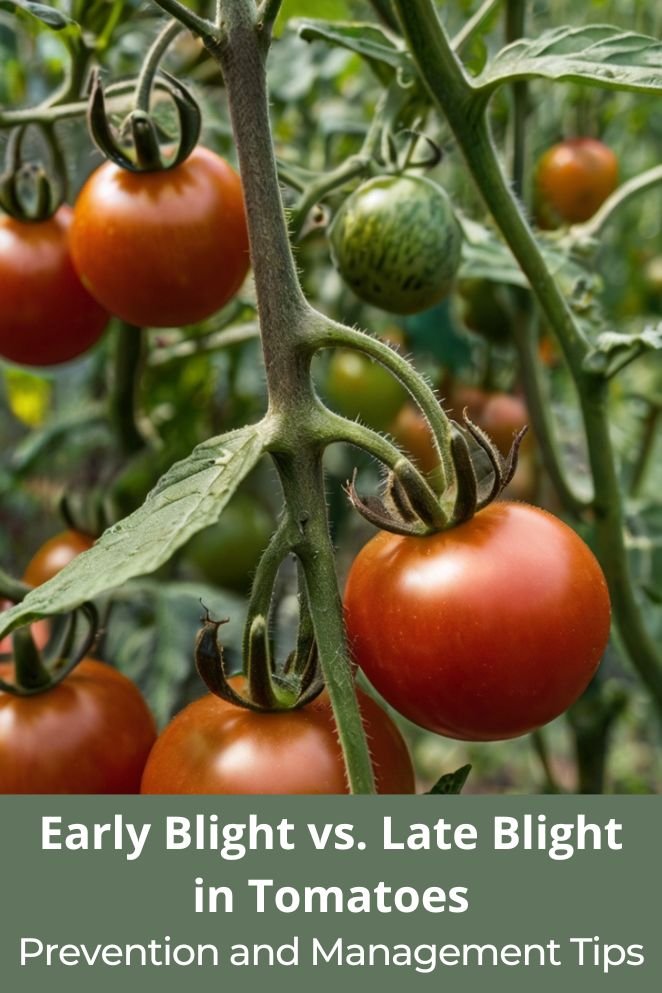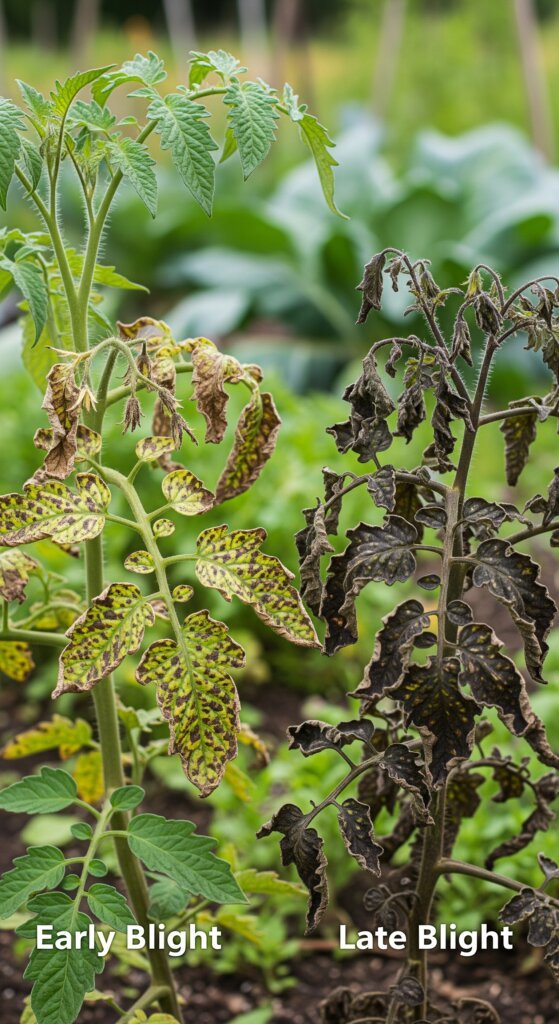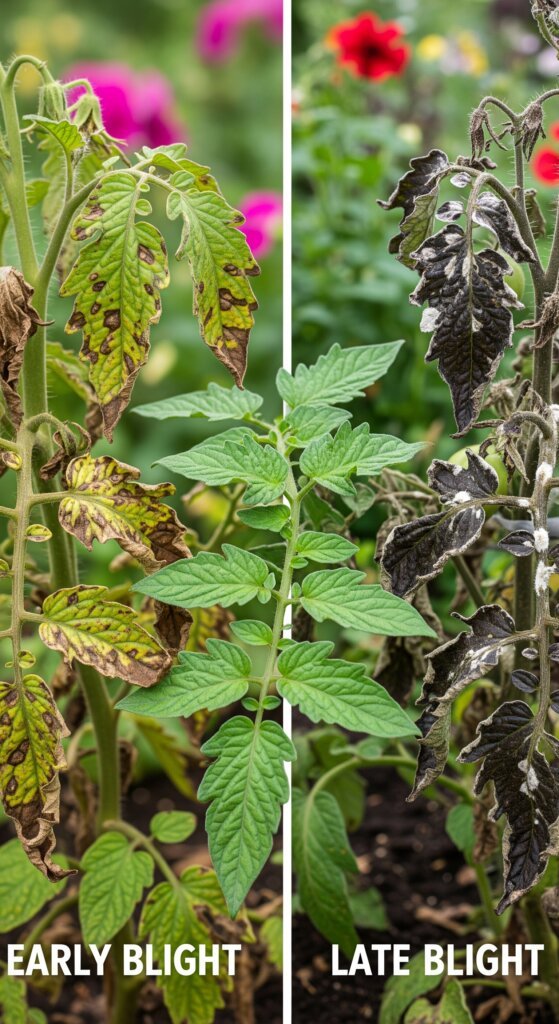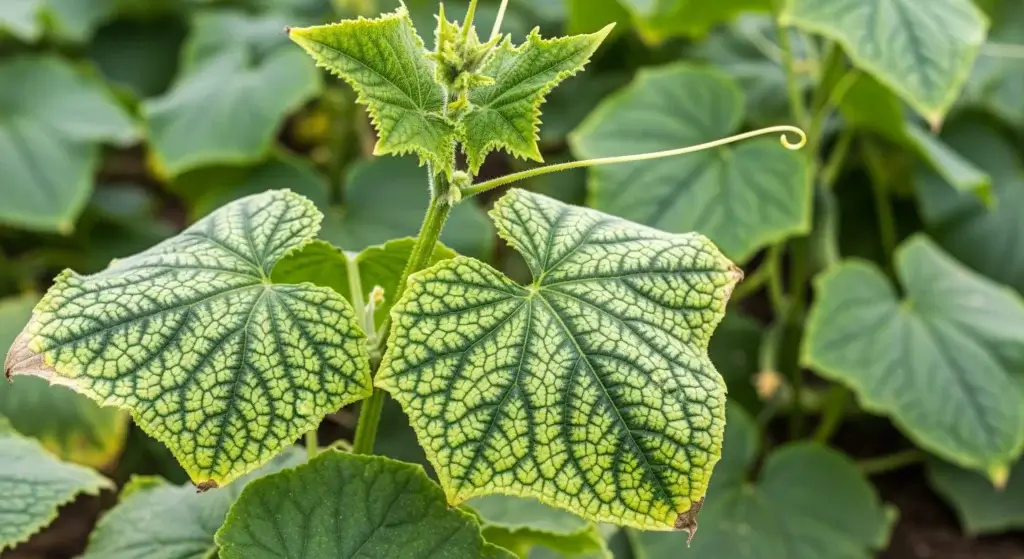
Tomatoes are the Beyoncé of your garden—but early blight and late blight are the drama queens ready to crash the party.
Know the difference, spot them quick, and you’ll keep your plants thriving and your sauce game strong.
Keep those blights in check and let your tomatoes shine!
Understanding the Culprits
Early Blight (Alternaria solani)
What it is:
A fungal pathogen that shows up in warm, humid weather like it owns the place—think tank-top season for fungi.
It causes those classic concentric, bull’s-eye spots on older leaves and can jump to stems and fruit if you’re not careful .
How it spreads:
It hitches rides on wind gusts, rain splash, and even your gardening tools (guilty!).
Spores overwinter in plant debris, then germinate on wet leaves in just a couple of hours.
If leaf surfaces stay damp for 5–10 hours, you’ll see new spots forming within days.

Late Blight (Phytophthora infestans)
What it is:
Not actually a fungus but a water mold (an oomycete) that thrives in cool, wet conditions—basically soggy spring days.
It produces fast-spreading lesions on leaves and stems, often with a white, fuzzy “cottony” growth on the underside.
It’s the same beast that sparked the Irish Potato Famine .
How it spreads:
Late Blight is a speed demon—its sporangia (spores) launch into the air on rain-slicked breezes, hitch a ride on equipment, and splash through irrigation.
In ideal cool (50–70°F), damp weather, it can infect leaves within 3–5 days and travel miles on the wind.
Distinctive Symptoms
Let’s break down the telltale signs of these tomato villains, so you can catch their shady moves before they wreck your crop.
Early blight
- Leaves: You’ll see brown spots with those famous bull’s-eye or concentric rings, usually chilling on the lower leaves. Around those spots? A yellow halo like the plant’s throwing a “warning” party.
- Stems: Near the soil line, expect dark, sunken lesions—basically the plant’s version of a zit that’s way worse.
- Fruits: Early Blight doesn’t just stop at leaves; it hits your tomatoes with sunken dark spots near the stem end, making your fruit look less Instagram-worthy.
Late blight
- Leaves: It starts with water-soaked lesions that look like your tomato just took a bad shower. These spots quickly turn brown and often sport a fuzzy white fungal “mustache” on the underside.
- Stems: Dark brown or black lesions develop, causing the stem to collapse like a soggy house of cards.
- Fruits: The damage spreads to your tomatoes with firm brown spots that get soft and rotten faster than you can say “pizza topping disaster.”

Prevention Strategies
Fighting early and late blight is all about staying one step ahead—like dodging spoilers for your favorite show.
Here’s your game plan, broken down so you can keep those tomatoes thriving without drama.
Cultural practices
- Crop rotation: Don’t plant tomatoes or their cousins (peppers, potatoes, eggplants) in the same spot for at least two years. It keeps the soil from turning into a blight breeding ground.
- Proper spacing: Give your plants room to breathe! Crowded tomatoes turn into a humid sauna, perfect for fungal parties.
- Watering wisely: Forget overhead sprinklers; drip irrigation is your BFF here. It delivers water straight to the roots and keeps leaves dry.
- Mulching: Spread mulch around your plants to stop soil from splashing onto leaves during watering or rain. It also helps keep moisture steady and your tomatoes happy.
Sanitation
- Tool hygiene: Your garden tools can be sneaky blight carriers. Clean and disinfect them regularly.
- Debris cleanup: Old leaves and plant scraps are blight’s favorite hangout spots. Clear them out ASAP to cut off the infection sources and keep your garden fresh.
Pick resistant varieties
If you want to stack the odds, go for tomato types known to laugh in the face of blight—varieties like ‘Mountain Magic’ and ‘Defiant’ are basically the superheroes of the tomato world.
They give you a fighting chance to skip some of the headache.
Management and Treatment
When blight crashes your tomato party, you’ve got to act fast and smart.
Here’s the lowdown on managing these pesky diseases like a pro (or at least like a friend who’s got your back).
Early blight
Fungicides
At the first sign of those telltale brown spots, reach for fungicides with chlorothalonil or copper-based formulas.
Think of them as the garden’s version of a firewall—blocking the bad stuff before it spreads.
Pruning
Grab your pruning shears and cut off those infected leaves.
It’s like quarantine for your plants—cutting out the sick parts slows down the disease and keeps the rest of your tomato squad healthy.
Late blight
Immediate removal
If you spot late blight’s nasty water-soaked lesions, don’t mess around.
Pull those plants up and toss them in the trash (not the compost!). It’s the nuclear option, but necessary to stop the infection from going viral.
Fungicides
Use fungicides made for late blight and spray before the weather gets cozy and wet—because blight loves damp drama.
Preventative action here is like wearing your raincoat before the storm hits.

Wrap-Up: Stay Sharp, Beat the Blight
Early and late blight might be the unwelcome party crashers of your tomato patch, but staying on your toes makes all the difference.
Spotting them early, playing defense with smart prevention, and jumping in with the right moves can save your crop from a total meltdown.
Keep checking your plants like a detective on a mission, mix up your tactics, and your tomatoes will stick around for the big, juicy finale.
Trust me, your garden—and your taste buds—will thank you.



